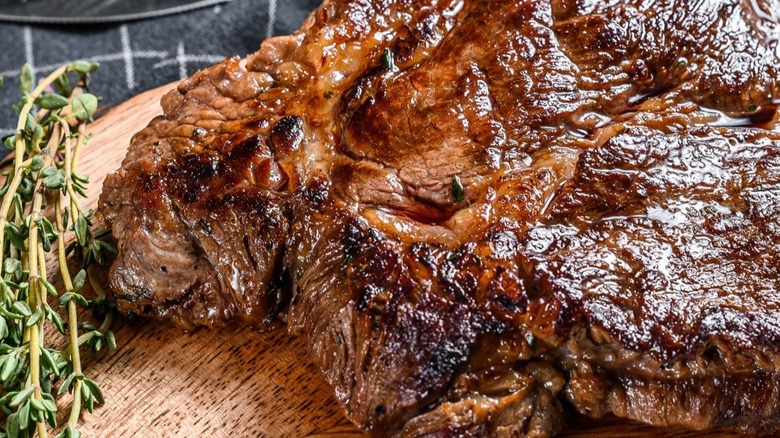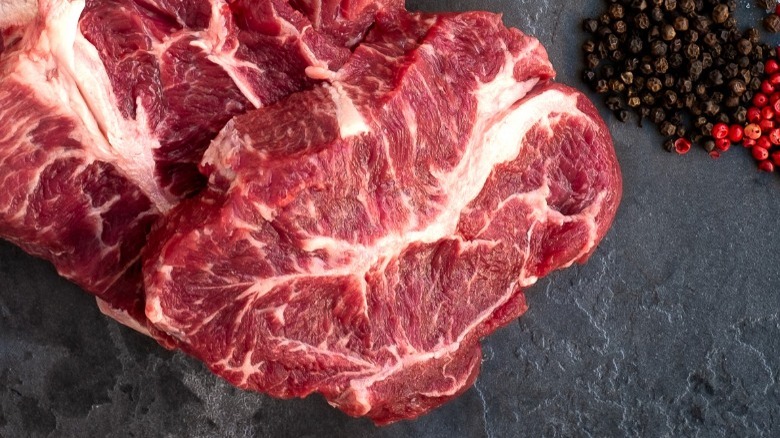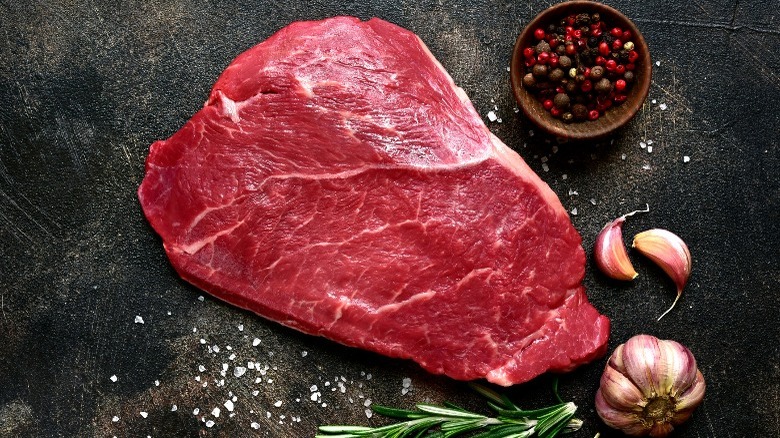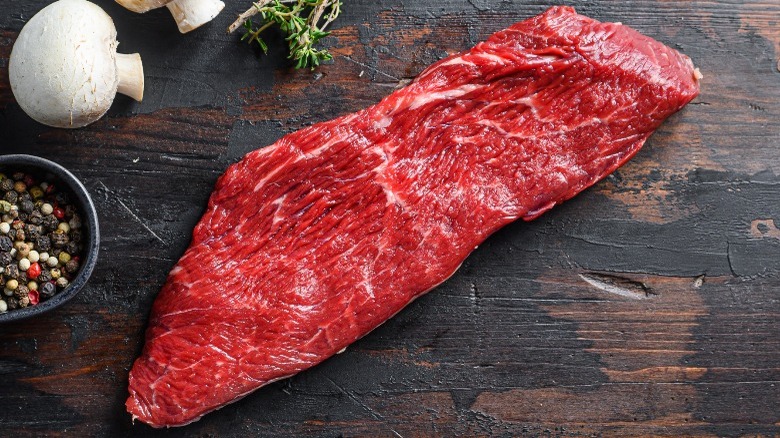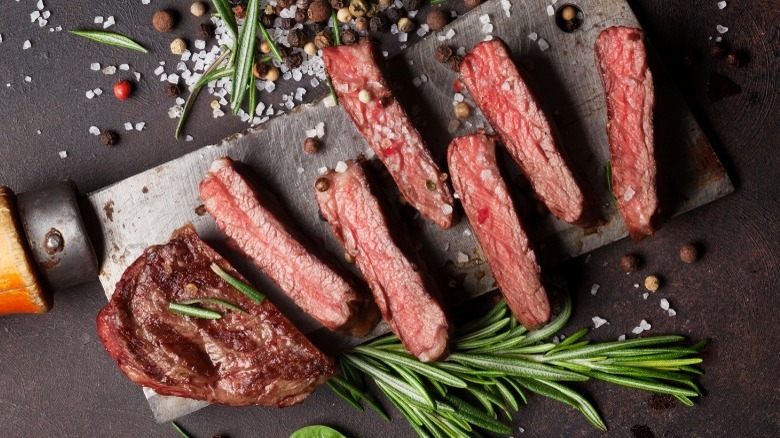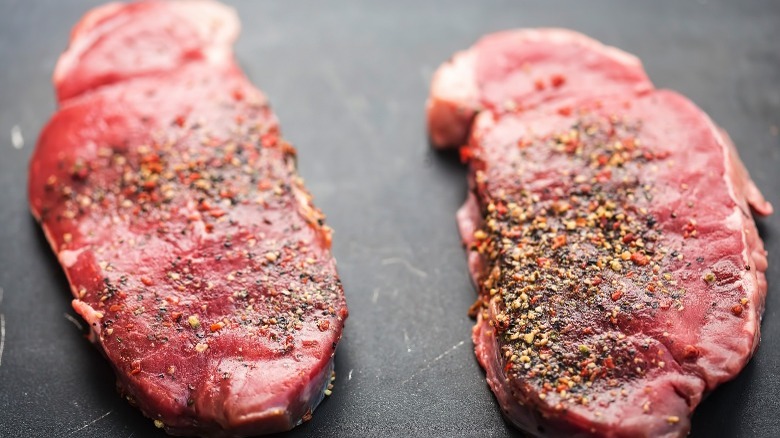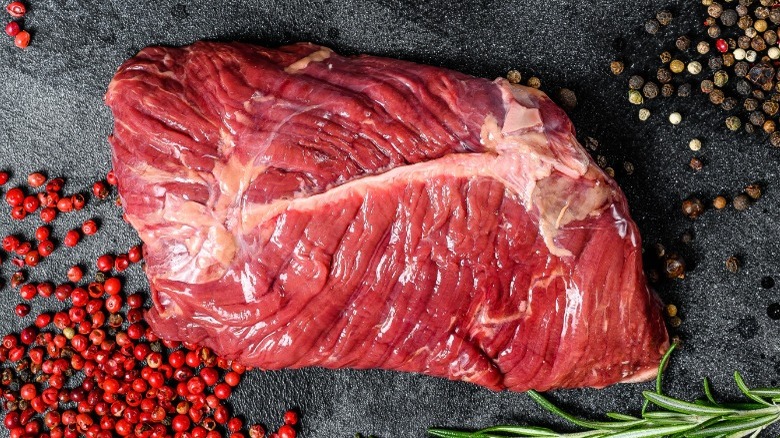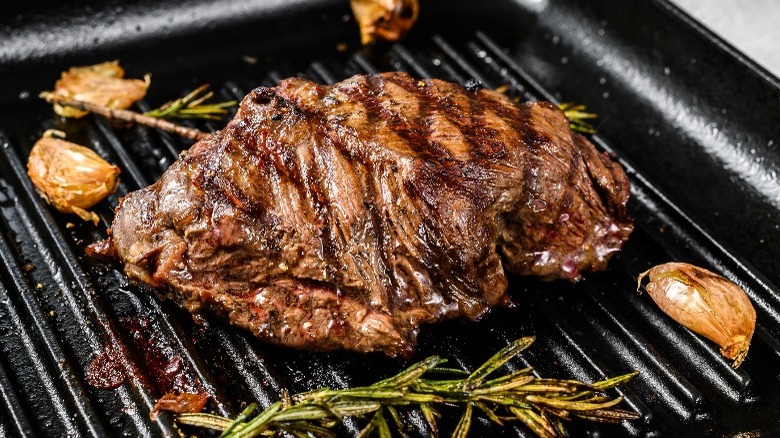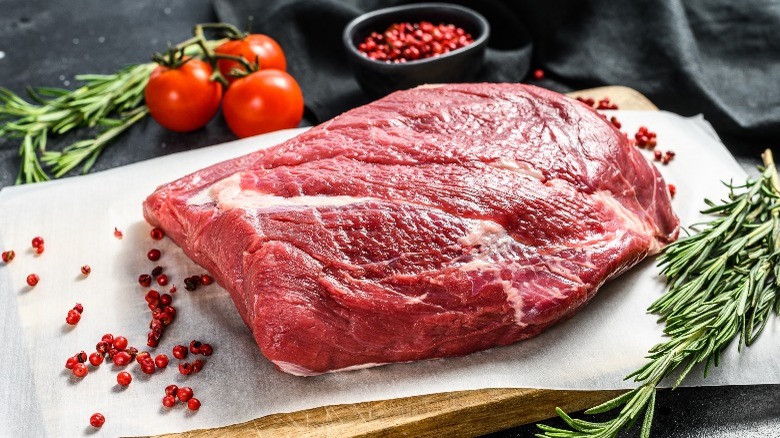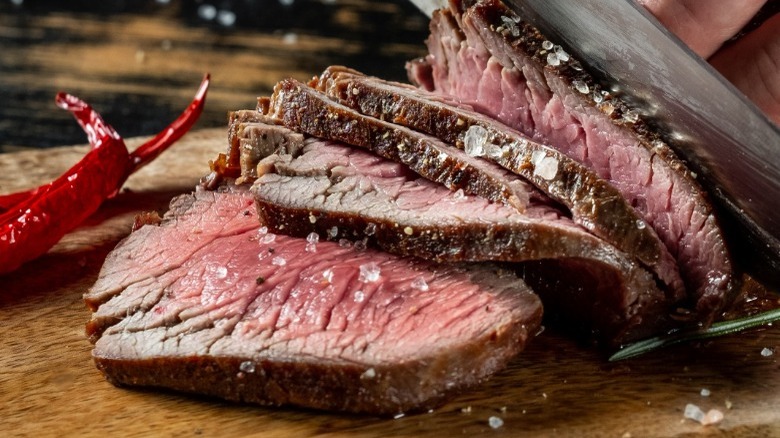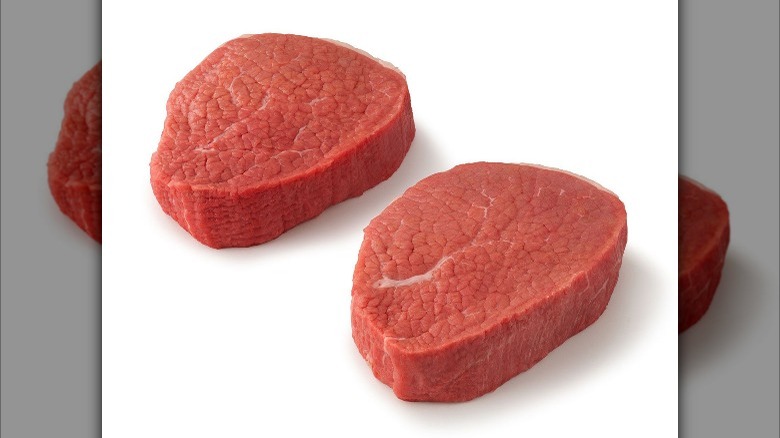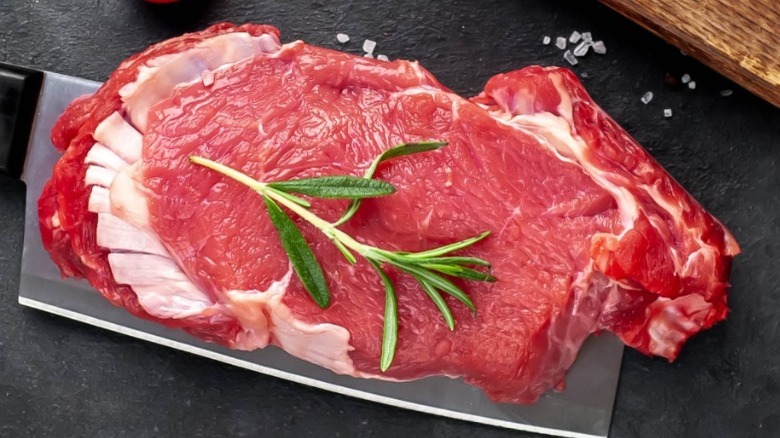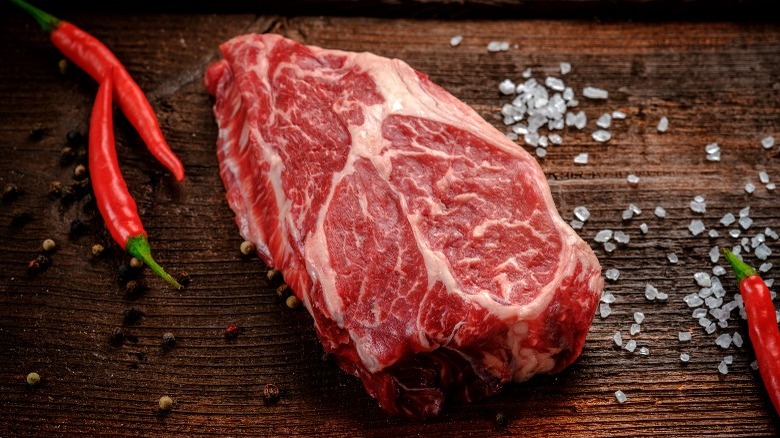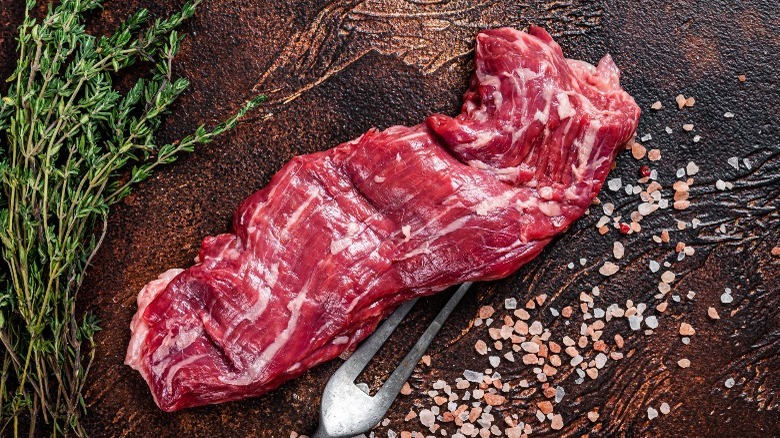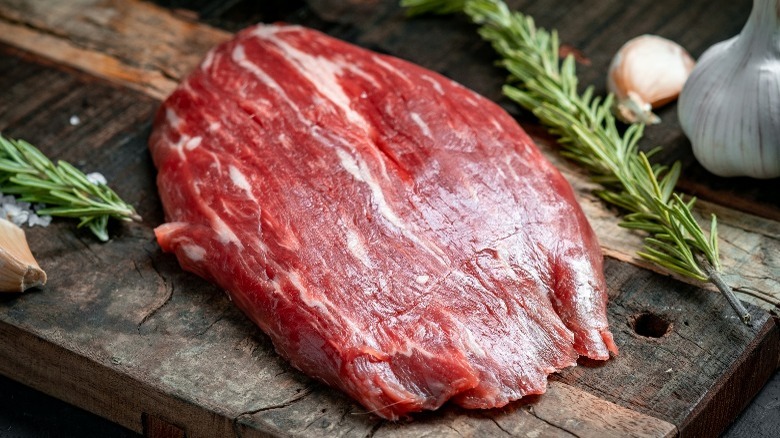14 Cheap Steaks You Should And Shouldn't Buy
Sure, there are plenty of fantastic steakhouses across the United States, but cooking up a slab of beef at home is almost always a little easier on the wallet. A tasty steak that melts in your mouth is one of life's great pleasures. But rising labor costs and increasing international demand for U.S. beef have pushed the prices to new heights. However, if you know what to look for, there are many cheap steaks that will save you money and still deliver in flavor and texture.
So, which are the cheap steaks and which ones are worth buying? For a cheap cut of meat to be enjoyable, it must have that distinctive beefy taste and a deliciously tender texture. Unfortunately, with some cheap steaks, a slight increase in temperature or a minute too long on the grill and they'll be as tough as old leather. Luckily, we've also found several that are just as delicious as the premium cuts of steak and will have you salivating with anticipation.
The steak you choose is largely a matter of personal taste, but we've got some great recommendations of affordable steaks that you should buy and some that you shouldn't.
1. Should: Blade chuck steak
If you're a fan of the beautifully marbled texture of ribeye, then the blade chuck steak is the perfect affordable alternative to shop for. Found in the chuck primal close to the blade muscle, blade chuck steak is packed with flavor. It's run through with veins of fat that make this some of the most succulent meat you'll find on a cheap steak.
Although shoulder cuts like this are commonly cooked slowly, you'll best experience the blade chuck steak on the grill. As the meat sears and the fat melts, it will tenderize the meat and intensify the taste. You won't match the tenderness of a tenderloin here, but you'll be surprised by just how succulent this steak can be.
Most blade chuck steaks will weigh anything from 8 ounces to 14 ounces, and although you may not find them at every butcher's counter, they're becoming increasingly common. They remain relatively cheap, and according to FoodFireFriends, you should be able to pick one up for between $9 and $16 per pound.
2. Should: Shoulder steak
Shoulder steak is cut from the chuck area of the cow. You can cook it any way you like but Beef. It's What's for Dinner recommends that you should marinate it first if you want to grill it. Any shoulder cut comes from hardworking muscles that can be tough but exceptionally tasty when cooked properly. With some careful preparation or slow cooking, the shoulder steak has a lot to recommend it. It has a light marbling of fat but none of the thick sections you can sometimes find in a blade chuck steak.
This cut is often overlooked because of the beef shoulder's reputation for tough meat or large slow-cooked roast joints. However, this has driven the price down to around $9 per pound (via Food Fire Friends). Although you're not getting fillet here and the meat has a coarser texture than most expensive cuts, it's still tender enough to enjoy out of the pan or off the grill.
3. Should: Tri-tip steak
Tri-tip steak has a triangular shape and comes from the bottom of the sirloin. It's lean, has some light marbling, and is perfect if you like your steak on the grill rare to medium. Best cooked on a high heat, the meat has a coarse texture but is still beautifully tender and provides lots of mouth-watering beef flavor.
This cut is particularly popular in California, where butchers gave it the name "Santa Maria Steak." You may need to adjust your cooking style slightly or even marinate it for a couple of hours, but the tri-tip steak is well worth the time on the grill. Once you've got the hang of preparing it to your liking, this is a steak you'll be enjoying time and time again.
In appearance and taste, the tri-tip steak lies halfway between the lean sirloin and the fat marbled ribeye. At about$8 per pound, it's significantly cheaper than both cuts of meat. If you're a fan of either of those popular cuts, you owe it to yourself and your wallet to buy a tri-tip steak today.
4. Should: Denver steak
Cut from the chuck area of the cow, directly underneath the shoulder blade bone, the Denver steak is surprisingly tender. It comes from the serratus ventralis muscle, which is relatively unused, giving it a smoother texture and making it perfect for grilling.
Denver steaks are beautifully marbled, affordable, and are becoming immensely popular. They're often grilled on a high heat and sliced against the grain. You can eat them immediately, add them to steak sandwiches, or serve them with salads.
Although it's unclear why this steak was given the name Denver, it was first cut during a quest for new steaks by butchers and food scientists. They were tasked with finding a steak with premium characteristics from the cheaper parts of the cow. Once you've tried your first Denver steak, you'll realize just how successful they were in showcasing this cut of beef. Even though this steak has grown in popularity, it still remains affordable and can be found in some areas at about $13 per pound.
5. Should: Ranch steak
Also known as boneless chuck, the ranch steak is cut from the center portion of the shoulder. It's sliced across the grain to produce a very lean steak with no fat around the edges. Despite the lack of fat, it still provides a deep beefy flavor that's too good to miss out on.
The ranch steak features the smooth texture of sirloin paired with the deep beefiness of most shoulder cuts. According to Just Cook, it's at its best when cooked medium-rare and ladled with melted butter. If you cook it for too long or aim to do it well-done, it may develop a tough, chewy texture that won't do the meat justice and could leave your jaw sore by the end of the meal. However, if you prefer your meat well-done, you could marinate it for a couple of hours or use a tenderizer before cooking.
Most ranch steaks are cut to an inch thick and weigh a maximum of 10 ounces. This is one of the cheapest cuts of beef, and the prices can be as low as $5 per pound.
6. Should: Top blade steak
The top blade steak is one of the most tender steaks available and is still incredibly affordable. It's cut when butchers slice across the top blade muscle in the cow's shoulder. This relatively new cut delivers rich flavor and a smooth texture. The price of top blade steak can be as low as $5 per pound, but in some areas, it costs closer to $11.
The only downside to the top blade steak is the seam of sinew that runs down its center. It's this that keeps the price down and has prevented it from becoming popular in the past. However, the top blade can still provide excellent value and tastes great.
If you place it in a pan and braise it with good beef stock, you'll retain the fantastic taste while the meat and connective tissue soften up. If you prefer to take less time cooking, you can also cut the sinew out and pan fry or grill the meat on high heat.
7. Should: Flat iron steak
Flat iron steaks are what you get when a butcher has removed the sinew from the top blade steak (though some butchers leave it in). The result is a well-marbled steak with enough flavor to have your mouth watering in anticipation. The extra steps involved in butchering a flat iron steak make them harder to find and a little more expensive, but they're still affordable and delicious.
The lack of central sinew means that the flat iron steak is perfect for cooking on a hot grill or in a pan. It's also very versatile and can be sliced into thin strips and used to bring a hit of beefy flavor to any number of dishes.
The shape of this cut means that it's a much tastier option for recipes that suggest using a skirt or flank steak. At the time of this writing, you can pick up a flat iron steak at Kroger for the affordable price of $5.99 per pound.
8. Shouldn't: Top round steak
Cut from the area of the cow where the leg and rump meet, the top round steak is cheap but best avoided. The round primal cut is excellent for slow-cooked roasts, but for steak, it doesn't deliver the intense flavor provided by some of the fattier chuck steak cuts.
According to data collected by Statista, the price of the top round steak reached $7.34 per pound in 2021. However, as of March 2022, Target was offering a price of $6.49 per pound. Many people see the top round steak as a good budget option because it's so cheap, but to get a texture that makes this steak worth your attention, it must be slow-cooked or broiled. If you want to save money, many other steaks are the same price but offer double the taste.
If you prefer your steak cooked rare or medium-rare on a hot grill, we recommend you ditch the round steak and go for one of the other great cheap cuts.
9. Shouldn't: Bottom round steak
Cut from the area above the cow's hind legs, the bottom round steak provides good flavor, but is too tough for frying or grilling. As with most cuts from this area of the cow, they're okay if you want a tightly textured lean roast, but as a steak, they're far too chewy to really enjoy.
The bottom round steak has an even tighter grain than the top round steak. Despite being on the lean side, there is some noticeable marbling in this cut, bringing some extra depth to the flavor. If you buy a bottom round steak, you'll need to marinate it for several hours, slow cook or broil it and then cut it very thinly. Even then, some people still find it excessively stringy. But why go to all that trouble when so many other cheap steaks are so much better?
According to FoodFireFriends, a pound of bottom round steak can cost anything from $5 to $10. However, the current price at Walmart is $7.44 per pound.
10. Shouldn't: Eye of round steak
There is nothing worse than a tough steak. The excitement builds as you cook it; it looks great and smells incredible but ultimately ends in disappointment. The first piece you try sticks in your teeth, and no matter how much you chew, it remains inedible. This is what you can expect from an eye of round steak. This steak comes from the center of the long, tough muscle in the cow's back leg. It's only worth considering if you're planning on making a stew, but even then, you'll need to make sure you cook it low and slow for several hours.
This cut may tempt you because of its low price, which can vary between $7 per pound and $9 per pound. However, we recommend you give it a miss. Why spend ages perfecting your cooking techniques when many other cheap cuts are significantly more versatile?
11. Shouldn't: Chuck center steak
Chuck center steaks are cut from the upper shoulder of the cow. There are several cheap cuts to be found in the chuck that will surprise you with their flavor and tender texture; unfortunately, this is not one of them. The chuck center steak delivers the taste but is too tough unless you've got the patience to marinade or broil it.
As well as the unpleasant texture, chuck center steaks are run through with chunks of fat and gristle. They're hard to remove and appear regularly throughout the steak, ruining any enjoyment of the rest of the meat. Do you really want to have to work at the dinner table to enjoy a good steak?
If you ever make the mistake of buying a chuck center steak, your only option is to try a wet cooking method like braising. Pan-frying or grilling should be avoided and are likely to render your steak inedible no matter how skilled you are in the kitchen.
12. Shouldn't: Chuck eye steak
Cut from the same area as the chuck center steak, this is sometimes referred to as the poor man's ribeye. The chuck eye steak features plenty of fat and has a marbled texture throughout the meat. Disappointingly it's temperamental to cook and, if heated too fast, it quickly becomes unpleasantly chewy.
If you're hoping that a chuck eye steak will deliver the beautiful buttery soft, melt in the mouth texture of a good ribeye, you'll be disappointed. It has a similar flavor, but the meat is too coarse to be anywhere near as good. If you like to slow cook or braise your steaks, this may be a good option for you, but it's not going to work for those who want rarer steaks cooked quickly on a hot grill.
You can pick up a chuck eye steak for about $11 a pound at Walmart. If tenderized, cooked well, and sliced thinly, a chuck eye steak can be tasty. However, there are several cheap steaks that are much tastier and simpler to prepare.
13. Shouldn't: Skirt steak
Skirt steak is a classic cheap cut; it's been around for ages and is often the go-to piece of meat for anyone on a budget. However, most butchers can now provide you with a range of other cheap cuts, many of which are superior to this one.
Skirt steaks come from the plate area of the cow, which is on its underside just behind the front legs. This is a flat juicy steak that's alright if you plan on slicing it thinly but is too tough for most meals. It has a coarse texture that tends to get stringy when cooked for too long.
There's a lot of flavor to be had in this steak, but the amount of connective tissue running through it is enough to put some people off. While some chefs still rate the skirt steak as a tasty budget meal, it's best kept for stews, fajitas, or other dishes where you need to slice it thinly. Currently, you can find an Angus skirt steak for about $10 per pound at Target.
14. Shouldn't: Flank steak
Another classic cheap cut, flank steak, is found on the underside of the cow, just in front of the back legs. According to The Pricer, a pound of flank steak will likely cost you between $9 and $14. Even at such a reasonable price, this is a cut for emergencies only; if you have no access to any other beef whatsoever, then maybe buy some. But when tri-tip steaks or flat iron steaks are available, it makes no sense to opt for flank.
If you buy it, flank steak will rank as one of the toughest cuts you've ever had. It's incredibly temperamental, and slight alterations in cooking time or temperature can make it dry and chewy. As well as featuring lots of coarse fibers throughout the meat, this is one of the leanest cuts available, and there's very little fat available to boost the flavor. With so many better and cheaper steak cuts out there, you'll get more bang for your buck if you skip the flank steak and go for another cut.
